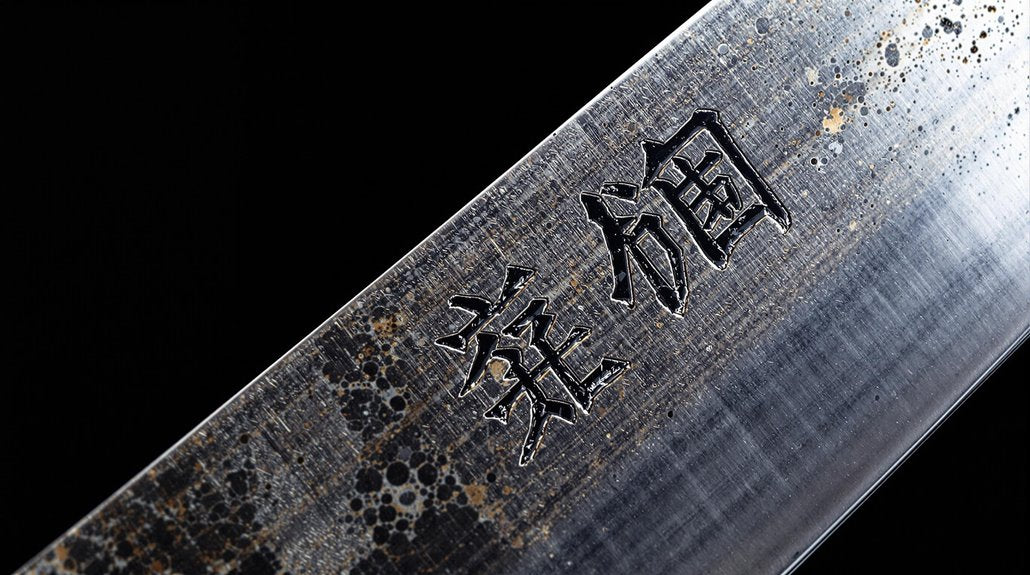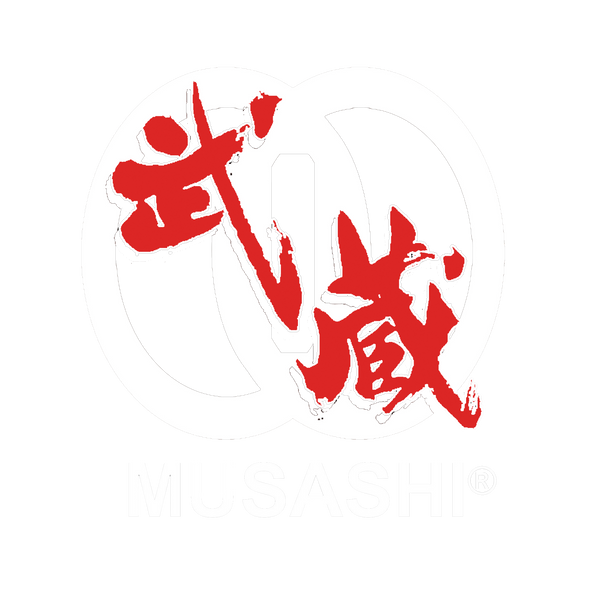
Reading Tantō Signatures and Markings
Share
Tantō blade markings show important details carved into the metal base. The marks tell us who made the blade, when it was made, and which group of craftsmen created it. The writing appears in a specific way - running from top to bottom along the back of the blade. By studying how the characters are written, where they are placed, and what the metal is made of, experts can tell if the markings are real. These special markings help tell the full story of each blade’s past.
Key Takeaways
- Signatures are carved into the tang, reading top-to-bottom near the blade’s back edge, revealing maker’s name and details.
- Authentic signatures combine specific writing styles, positioning, and depth of carving unique to each region and time period.
- Date marks incorporate era names and temporal indicators, helping authenticate the blade’s age and origin.
- Different regional schools had distinct signature styles, with Bizen, Mino, and Sōshū each following specific conventions.
- Examine character accuracy, marking style consistency, and signs of artificial aging to identify authentic tantō signatures.
The Anatomy of a Tantō Signature
A sword maker’s name, or mei in Japanese, is carved into the handle base (tang) of a tantō blade. By looking closely at these markings, experts can tell who made the blade, where it was made, and when.
The smith cuts each letter into the metal by hand, using special tools to make marks of different sizes and shapes.
The writing goes from top to bottom, starting near the blade’s back edge. The signature can show the maker’s first and last name, special titles, the area where it was made, and sometimes religious blessings.
These marks help prove the blade is real and tell its story to collectors and researchers.
Common Signature Styles and Formats
A Japanese tantō blade can be signed in different basic ways that became standard during medieval Japan.
The main signature types are mei, which can be written across (horizontal) or up-and-down (vertical) on the blade’s tang. The maker would carefully place their name, where they worked, and when they made it in specific spots following old rules.
Some makers put signatures on both sides of the tang to include more information.
Others used short signatures with just the key details. Special tantō, especially those made for important people or ceremonies, sometimes had fancy carved designs around the signature.
Decoding Date Marks and Time Periods
Japanese tantō date marks frequently incorporate era names (nengō) that correspond to specific imperial reigns and historical periods. Common date patterns include both numerical year indicators and cyclical zodiac references, which require cross-referencing multiple dating systems for accurate interpretation.
The presence of these temporal markers can help authenticate blades and place them within specific schools of craftsmanship, though careful attention must be paid to distinguish genuine period markings from later additions.
Understanding Era Names
Era names are key to knowing when tantō blades were made in old Japan. The Japanese used special time period names called nengō to mark different times in their history.
These names were chosen based on big events, new emperors, or what people saw as good signs at the time.
Sword makers would write these era names when they signed their work, adding the specific year of that era. You might see names like Bunsei, Tenpō, or Kōka on these blades.
Common Date Mark Patterns
Japanese sword makers used clear patterns when writing dates on their tantō blades. Most often, they wrote the era name first, then the year using the zodiac system, and the month. Many added ‘hi’, meaning ‘day’, at the end.
This careful way of marking dates shows how precise sword makers were in their work. These date marks help experts today check if a blade is real and learn about when it was made.
Regional Marking Variations and Schools
In old Japan’s different areas, sword makers developed their own special ways of signing and marking their tantō blades.
Each area had its own look based on what the local people liked, what materials they could find, and what they believed in. How makers signed their work changed from place to place - some used fancy writing while others kept it simple.
- Bizen makers put small signatures on the right side and added special date marks
- Mino makers often put Buddhist signs next to their names
- Yamato makers carved their names in special ways
- Sōshū makers lined up their marks very carefully
- Yamashiro makers wrote their names near the bottom of the handle
Authentication Methods and Warning Signs
Experts check if tantō signatures are real using methods refined over many years of study.
They look closely at how the marks were cut, where they sit on the blade, and what metals were used - both under microscopes and through chemical tests.
Those who study signatures compare the marking’s look, depth, and aging against known real examples.
Fake signatures often show mistakes in the Japanese characters, use marking styles from the wrong time period, and have signs of fake aging.
To check if a signature is real, you need to know how markings changed over time and between different areas.
New tools like X-ray testing and digital pictures help support the old ways of checking.
Tools and Resources for Signature Study
Experts who study tantō signatures today use many special tools and guides. To properly check a signature, they need both tools for close-up study and trusted books built on years of research.
The Japanese Sword Museum and major sword groups keep large collections of records to help prove if signatures are real.
Key tools and guides include: - Strong magnifying glasses (10x-30x) to see tiny signature marks - Special cameras that can measure small details - Old Japanese books about sword signatures - Computer records with proven signature examples - Carefully chosen guides showing how marks differ by area
Frequently Asked Questions
How Much Does a Missing Signature Affect a Tantō’S Value?
A tantō without a signature is worth much less money, often losing 30-50% of its value. But if the blade is very well-made, has important history, or is in perfect shape, these good points can help make up for not having a signature.
Can Tantō Signatures Be Successfully Restored if Damaged?
Fixing damaged tantō signatures is not recommended since any changes hurt their authenticity. A signature with original damage is worth more historically and culturally than one that has been repaired.
What Causes Natural Signature Fading on Tantō Blades Over Time?
Natural aging makes tantō blade signatures fade away slowly over time. This happens when the blade is exposed to air, changing moisture levels, skin oils from handling, and other outside conditions that wear down the carved markings as hundreds of years pass.
How Often Were Left-Handed Smiths’ Signatures Different From Right-Handed Ones?
Sword makers who were left-handed mostly wrote their names the same way as right-handed smiths did. This was because Japanese writing schools taught everyone to sign in a standard way, no matter which hand they used better.
Why Did Some Master Smiths Deliberately Omit Certain Characters From Signatures?
Master smiths sometimes left out parts of their signatures for special reasons - to show their place in history, to add their own creative touch, or to mark their connection to certain teaching groups, while still keeping their work clearly real within their craft’s traditions.
Conclusion
Understanding tantō signatures and markings requires dedicated study of mei calligraphy, period-specific conventions, and regional stylistic variations. Through careful analysis of signature components, date marks, and school characteristics, collectors and scholars can authenticate these Japanese daggers with greater confidence. However, given the complexity of historical forgeries and variations, consultation with established references and experienced specialists remains crucial for definitive attribution. For expert guidance on Japanese sword authentication and collection, visit Musashi Swords, your trusted source for authentic Japanese blades.
